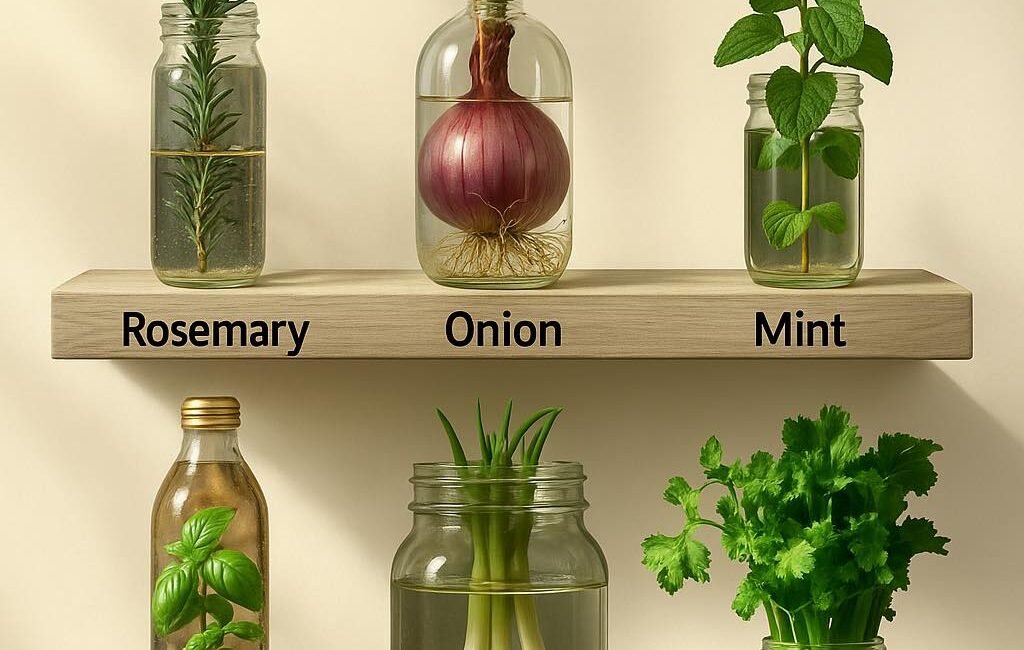Herbs are essential ingredients in many kitchens worldwide, offering flavor, color, and health benefits. However, it’s not always easy to grow fresh herbs, especially if you lack space or time. Luckily, some herbs can be grown directly in water, making them perfect for those living in apartments or without gardens. Growing herbs in water allows you to have a continuous supply of fresh, nutritious plants right at your fingertips.
This article introduces several popular herbs that you can easily grow in water right in your kitchen. We will cover how to grow herbs like rosemary, basil, garlic, celery, onion, and mint, and provide tips on how to care for them. These plants not only offer convenience but also health benefits and can naturally brighten up your kitchen in a practical and delightful way.
1. Rosemary: A Fragrant Herb to Grow in Water
Rosemary (Rosmarinus officinalis) is a popular Mediterranean herb known for its strong aroma and slightly woody flavor. It’s ideal for enhancing your dishes, particularly grilled meats, soups, and sauces. If you’re eager to grow rosemary but lack outdoor space, it can be easily grown in water.
How to Grow Rosemary in Water:
- Choose a Healthy Stem: Take a 10 to 15 cm cutting from a healthy rosemary plant, preferably one without flowers or buds. Ensure the stem is healthy and not damaged.
- Remove Lower Leaves: Remove the lower leaves from the stem, leaving a few leaves at the top. This helps prevent rotting underwater.
- Place the Stem in Water: Place the rosemary stem in a jar or glass of water, ensuring the bottom of the stem is submerged. Make sure the leaves remain above the water level.
- Change Water Regularly: Change the water every 2 to 3 days to maintain freshness and avoid the growth of mold or bacteria.
- Provide Light: Rosemary thrives in bright light, so place the jar near a window where it can receive indirect light.
- Wait for Roots to Form: After a few weeks, roots will begin to form. Once the roots reach about 5 cm, you can either transplant the rosemary into a pot of soil or keep it in water for a hydroponic garden.
Why Grow Rosemary in Water?
Rosemary is easy to propagate in water and can quickly multiply from cuttings. Not only is it a flavorful herb for cooking, but it also has medicinal properties, such as stimulating blood circulation and offering antioxidant effects.
2. Basil: A Versatile and Easy-to-Grow Herb
Basil (Ocimum basilicum) is a beloved herb used in various dishes, especially for making pesto, salads, and pasta sauces. Growing basil in water is a quick and efficient way to enjoy its fresh taste.
How to Grow Basil in Water:
- Select a Healthy Cutting: Take a 10 to 15 cm cutting from a healthy basil plant. Avoid using flowering stems as they can prevent proper growth.
- Remove Lower Leaves: Remove the lower leaves so that the stem doesn’t touch the water, which could cause rot.
- Place in a Jar of Water: Place the cutting in a jar of water, making sure the bottom of the stem is submerged.
- Provide Light: Basil enjoys bright light but not direct sunlight. A location with indirect light is ideal.
- Change the Water Regularly: Change the water every 2 to 3 days to prevent mold and maintain root growth.
- Wait for Roots to Form: Within a few days, you should see roots beginning to grow. Once the roots are 2 to 5 cm long, you can replant the basil in soil or continue growing it in water.
Why Grow Basil in Water?
Basil is not only easy to grow in water, but it’s also packed with antioxidants and has anti-inflammatory properties. Growing basil at home ensures a steady supply of fresh leaves for your dishes.
3. Garlic: Simple to Grow and Full of Flavor
Garlic (Allium sativum) is another plant that can be easily grown in water. While you cannot grow a full bulb, garlic shoots (green stems) can be cultivated in water, and they have a milder taste than traditional garlic. These shoots can be used as a garnish or in sauces.
How to Grow Garlic in Water:
- Choose a Clove of Garlic: Take a garlic clove and place it, skin intact, in a jar.
- Place the Clove in Water: Ensure the base of the clove is submerged in water while the top remains above the waterline.
- Provide Light: Place the jar in a spot where it receives indirect light.
- Change Water Regularly: Change the water every 2 to 3 days to maintain freshness and prevent rot.
- Harvest the Shoots: Within a few days, green shoots will start to emerge. You can harvest these shoots when they reach about 10 cm long.
Why Grow Garlic in Water?
Growing garlic in water is a practical way to get fresh green shoots throughout the year, and these shoots are perfect for adding a subtle garlic flavor to your dishes.
4. Celery: Easy to Grow and Always Useful in the Kitchen
Celery (Apium graveolens) is another surprisingly easy plant to grow in water. Not only does it provide crunchy stalks for your salads and soups, but its leaves can also be used for garnishing. Growing celery in water ensures you always have fresh, healthy stalks at hand.
How to Grow Celery in Water:
- Choose a Celery Stalk: Take a fresh stalk of celery, preferably with the roots still attached.
- Cut the Base: Cut about 2 cm off the base of the celery stalk, then place the cut base in a jar of water.
- Provide Light: Celery prefers bright, indirect light, so place the jar in a well-lit spot but away from direct sunlight.
- Change Water Regularly: Change the water every 2 to 3 days to encourage healthy growth.
- Harvest the Stalks: After about a week, you will see new growth emerging from the center. You can harvest the stalks as they grow or let them continue to develop.
Why Grow Celery in Water?
Celery is a nutritious plant rich in vitamins and antioxidants. By growing it in water, you’ll have fresh stalks at your disposal while reducing food waste, as you’re regenerating a plant from what would otherwise be discarded.
5. Green Onions: A Flavorful and Easy-to-Grow Herb
Green onions (Allium fistulosum) are a fantastic option for growing in water. Used in a variety of dishes, they add flavor and color to your recipes. Green onions are also perfect for beginner gardeners, as they grow quickly and easily.
How to Grow Green Onions in Water:
- Choose Green Onions: Take a few green onion stalks and cut them just above the roots.
- Place in a Jar of Water: Place the roots in a jar or glass of water, making sure the roots are submerged.
- Change Water Regularly: Change the water every 2 to 3 days to keep it fresh and encourage root development.
- Harvest the Stalks: The green onions will begin growing in a few days. You can cut the stalks as they grow, leaving the roots intact.
Why Grow Green Onions in Water?
Green onions are easy to grow in water and can be harvested continuously. They are rich in vitamins, especially vitamin C, and are beneficial for heart health.
6. Mint: Fresh and Fragrant, Perfect for Growing in Water
Mint (Mentha) is a fragrant herb that can easily be grown in water. Used in drinks, desserts, or savory dishes, mint adds a refreshing and light touch to your recipes.
How to Grow Mint in Water:
- Choose a Mint Cutting: Take a 10 cm cutting of mint and remove the lower leaves.
- Place in Water: Place the cutting in a jar of water, ensuring the bottom of the stem is submerged.
- Provide Light: Mint prefers indirect light. Place the jar near a window that gets indirect light.
- Change Water Regularly: Change the water every 2 to 3 days to ensure optimal growth.
- Harvest the Leaves: Once roots develop, you can start harvesting the leaves for your recipes.
Why Grow Mint in Water?
Mint is easy to grow and offers numerous health benefits, including aiding digestion and providing anti-inflammatory effects. It’s also perfect for refreshing drinks like iced tea or mojitos.
Conclusion
Growing herbs in water is a simple and cost-effective way to add fresh flavor to your kitchen. Plants like rosemary, basil, garlic, celery, green onions, and mint are all easy to grow in water, and with just a little care, you can enjoy a constant supply of fresh herbs for your meals. Additionally, these herbs bring health benefits and can reduce food waste by regenerating plants from what would otherwise be discarded. So why not transform your kitchen into a mini herb garden with these fresh, flavorful, and nutritious plants?




